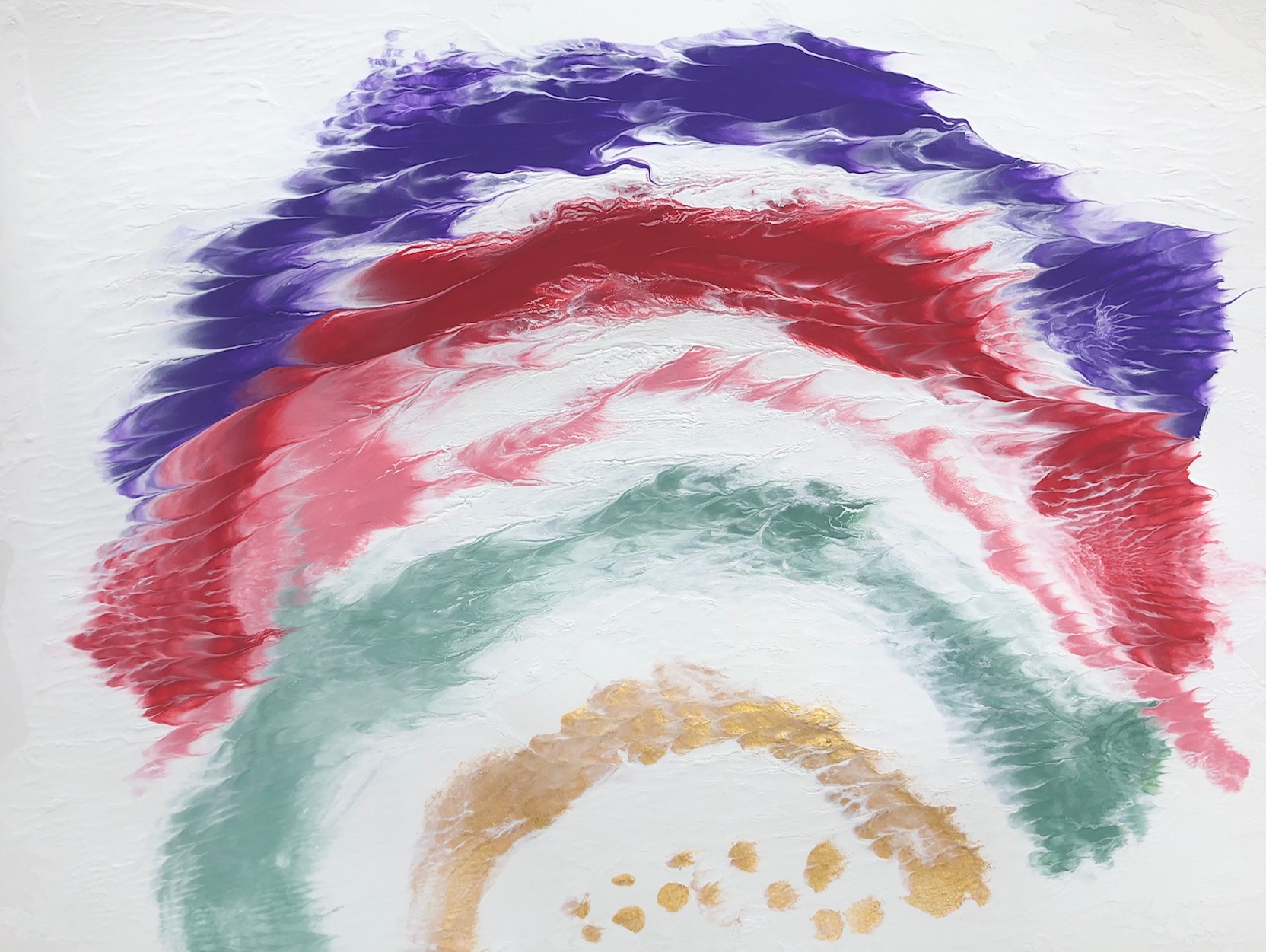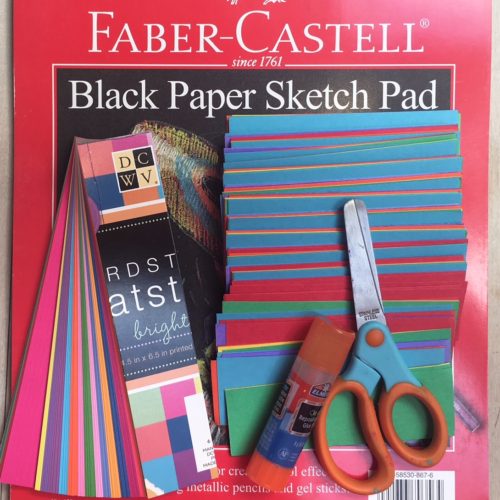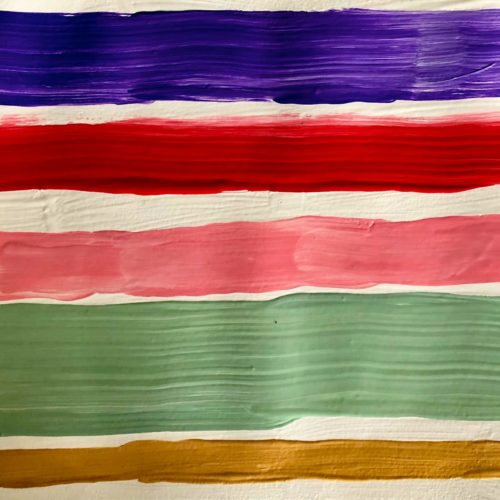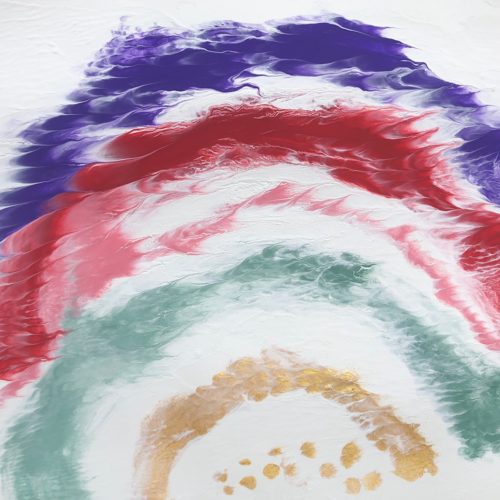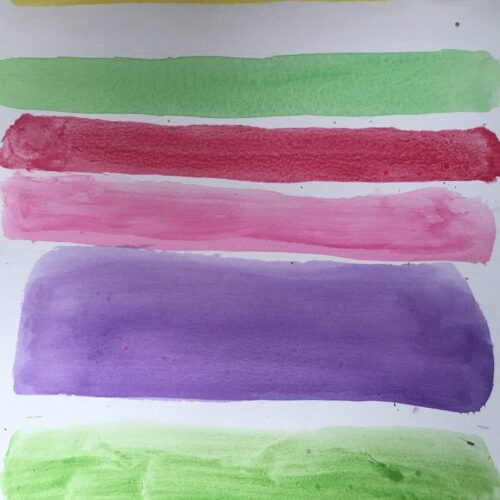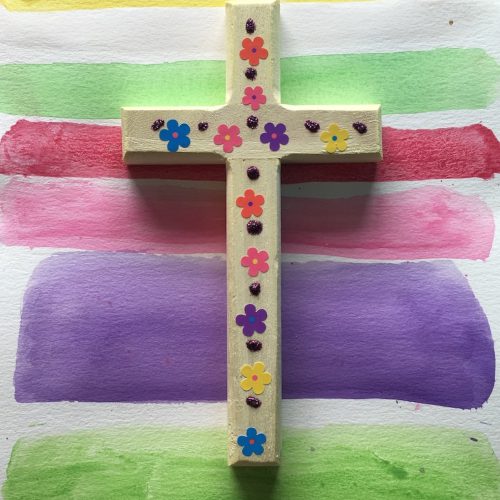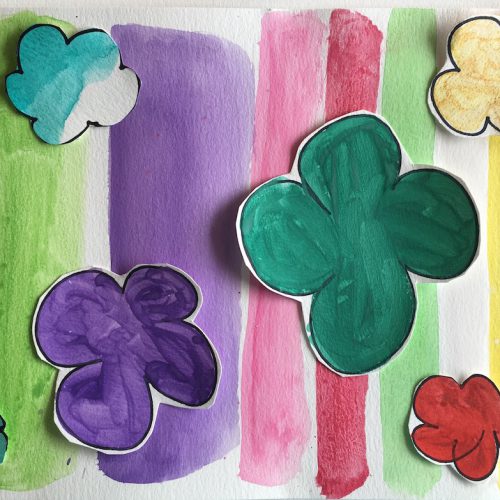“The theological virtues dispose Christians to live in relationship with the Holy Trinity. They have God for their origin, their motive, and their object-God known by faith, God hoped in and loved for his own sake.”
Source: The Catechism of the Catholic Church “The Theological Virtues”
For Parents to Teach to Their Children
“Faith, Hope and Charity are the cross, anchor, and burning heart that sustains us through the theological virtues and open us to the Gifts and Fruits of the Holy Ghost.”
Source: DailyCatholic.org “Catholicism Made Simple”
Our Art Gallery
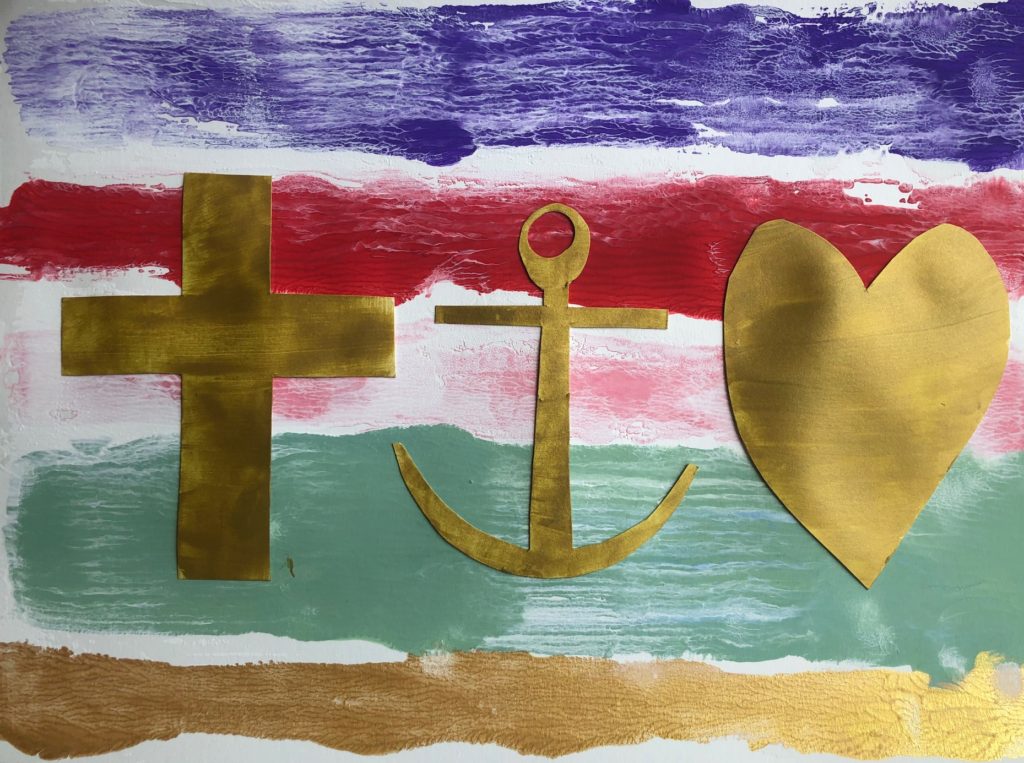
Our Liturgical Colors–Violet (Penance), Red (Sacrifice), Rose (Anticipation), Green (Ordinary Times), White and Gold (Purity and Joy) With Symbols of Faith, Hope and Charity
The graphic design below labels the Liturgical Colors with the names of the Liturgical Seasons. Ask your child what color the priest is wearing this week for Mass. We are in “Ordinary Time,” so the Chasuble (the outer garment) the priest wears is green. We will rapidly be approaching Advent, a wonderful season to explore the colors that appear in the church.

Learning about the Virtues
The Theological Virtues
1813 “The theological virtues are the foundation of Christian moral activity; they animate it and give it its special character. They inform and give life to all the moral virtues. They are infused by God into the souls of the faithful to make them capable of acting as his children and of meriting eternal life. They are the pledge of the presence and action of the Holy Spirit in the faculties of the human being. There are three theological virtues: faith, hope, and charity.77
1814 “Faith is the theological virtue by which we believe in God and believe all that he has said and revealed to us, and that Holy Church proposes for our belief, because he is truth itself. By faith “man freely commits his entire self to God.”78″
1820 “Christian hope unfolds from the beginning of Jesus’ preaching in the proclamation of the beatitudes. The beatitudes raise our hope toward heaven as the new Promised Land; they trace the path that leads through the trials that await the disciples of Jesus. But through the merits of Jesus Christ and of his Passion, God keeps us in the “hope that does not disappoint.”88″
1822 “Charity is the theological virtue by which we love God above all things for his own sake, and our neighbor as ourselves for the love of God.
1823 “Jesus makes charity the new commandment.96 By loving his own “to the end,”97 he makes manifest the Father’s love which he receives. By loving one another, the disciples imitate the love of Jesus which they themselves receive. Whence Jesus says: ‘As the Father has loved me, so have I loved you; abide in my love.'”
“And again: ‘This is my commandment, that you love one another as I have loved you.‘”98″
The Fruits of the Holy Spirit
“Charity, Joy, Peace, Patience, Kindness, Goodness, Generosity, Gentleness, Faithfulness, Modesty, Self-Control, Chastity.”
Source: LoyolaPress.org “Fruits of the Holy Spirit”
The difference between the virtues and the gifts of the Holy Ghost consists in this: the virtues enable us to do what our reason directs; the gifts make us follow the inspirations of the Sanctifier.”
Source: DailyCatholic.org “Catholicism Made Simple”
Our Reading–Luke, chapter 10:25-37 “The Parable of the Good Samaritan”
Source: USCCB.org
There was a scholar of the law who stood up to test Jesus and said,
“Teacher, what must I do to inherit eternal life?”
Jesus said to him, “What is written in the law?
How do you read it?”
He said in reply,
“You shall love the Lord, your God,
with all your heart,
with all your being,
with all your strength,
and with all your mind,
and your neighbor as yourself.”
He replied to him, “You have answered correctly;
do this and you will live.”
But because he wished to justify himself, he said to Jesus,
“And who is my neighbor?”
Jesus replied,
“A man fell victim to robbers
as he went down from Jerusalem to Jericho.
They stripped and beat him and went off leaving him half-dead.
A priest happened to be going down that road,
but when he saw him, he passed by on the opposite side.
Likewise a Levite came to the place,
and when he saw him, he passed by on the opposite side.
But a Samaritan traveler who came upon him
was moved with compassion at the sight.
He approached the victim,
poured oil and wine over his wounds and bandaged them.
Then he lifted him up on his own animal,
took him to an inn, and cared for him.
The next day he took out two silver coins
and gave them to the innkeeper with the instruction,
‘Take care of him.
If you spend more than what I have given you,
I shall repay you on my way back.’
Which of these three, in your opinion,
was neighbor to the robbers’ victim?”
He answered, “The one who treated him with mercy.”
Jesus said to him, “Go and do likewise.”
Christ Taught Us About the Corporal Works of Mercy
“The Corporal Works of Mercy are found in the teachings of Jesus and give us a model for how we should treat all others, as if they were Christ in disguise. They ‘are charitable actions by which we help our neighbors in their bodily needs’ (USCCA). They respond to the basic needs of humanity as we journey together through this life.”
Source: USCCB.org “The Corporal Works of Mercy”
Our Writing Project
Give your child a printed list of the Corporal Works of Mercy that they can copy for their poster. I bought a booklet of colorful strips of paper and gave the strips to my students in a Sunday School Class. The children used glue sticks, a black Sharpie pen and stickers for decoration. The children wrote the text then glued the strips onto large white watercolor paper, or black construction paper, to make their poster for their rooms, or perhaps the refrigerator door.
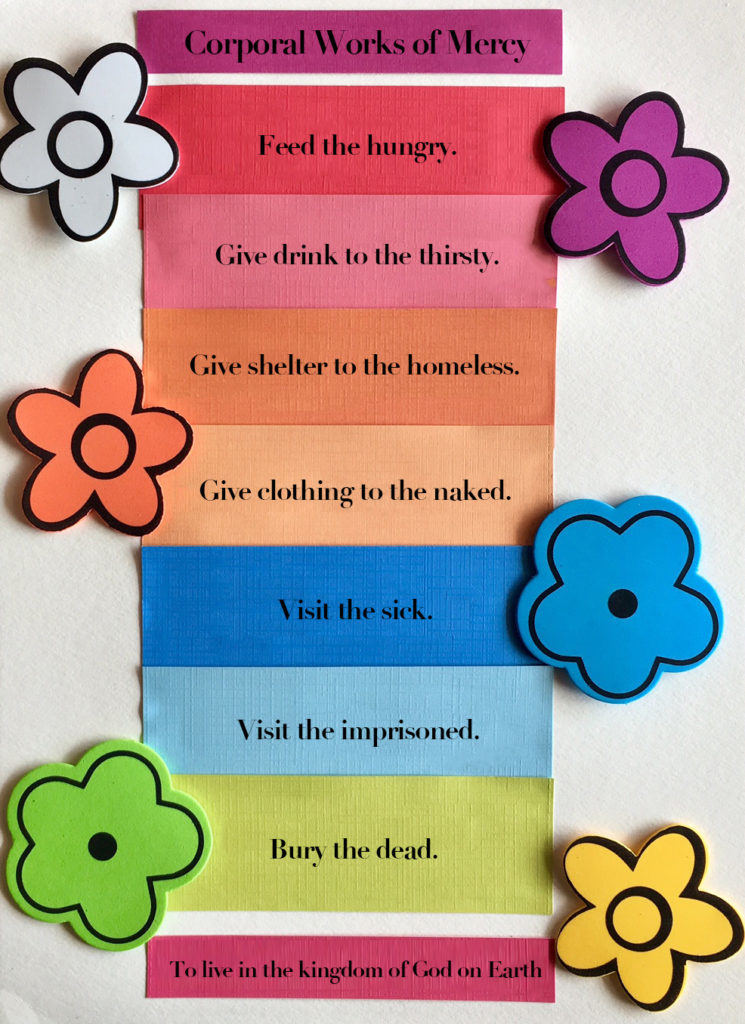
Our Materials
Our Art Project–The Theological Virtues

Our Materials
Suggested Homework Activities-Week Six
Read, “The Parable of the Good Samaritan” from Luke, chapter 10:25-37, with your child. You can read the story from your family Bible, a Catholic children’s Bible, or on-line from the USCCB.org. Ask your child about several of the characters: the victim; the robbers; the two travelers who independently ignored the beaten person; the Samaritan (a person from Samaria); and, the innkeeper. Two new words can be learned from this story: “Samaritan,” a modern-day term for a helper in a bad situation; and “witness,” a person who sees something occur. Police and other first responders use the word “samaritan” as a legal term for a helpful person who becomes involved in a situation to assist someone. A person (a witness) who sees an accident may be contacted to tell what he or she saw. A witness can be for something happy, too, like a baptism, a wedding, or a purchase of something important, such as a home.
Invite your family to make a drawing or painting of “Liturgical Colors” and label each color with a Sharpie to indicate the seasons that use each of the colors: Advent (violet), Christmas (white), Ordinary Time (green), Lent (violet), Palm Sunday (Red), Good Friday (Red), Easter (white), Pentecost (Red), Ordinary Time (green). If you prefer, list the Seasons on the back of the painting or drawing. Here are six painted “Liturgical Colors” art projects:
Please Click HERE (scroll to bottom of post) to see “In the Beginning” in Genesis for print-making process. Please note, use children’s acrylic paint for making a print. Each painter needs two pieces of watercolor paper–one for the original, the second piece to place on top of the first painting. Press down on second sheet, then gently peel off to make a print. I almost always prefer the second print. It’s fun!

